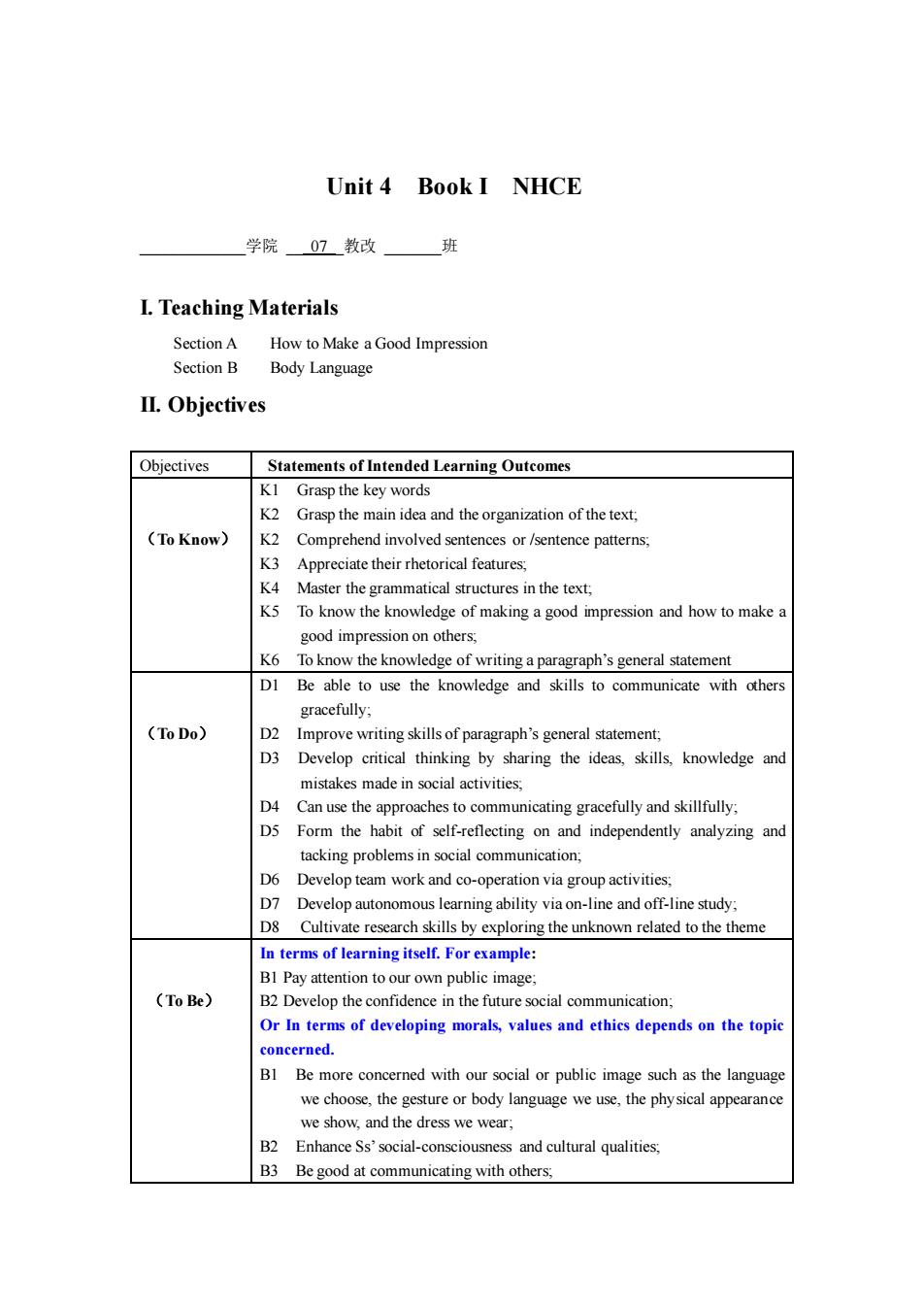
Unit 4 Book I NHCE 学院07教政班 I.Teaching Materials SectionA How to Make a Good Impression Section B Body Language II.Objectives Objectives Statements of Intended Learning Outcomes KI Grasp the key words K2 Grasp the main idea and the organization of the text. (To Know) Comprehend invoved sente/. K3 Appreciate their rhetorical features; K4 Master the grammatical structures in the text: K5 To know the knowledge of making a good impression and how to makea good impression on others. K6 To know the knowledge of writinga paragraph's general statement DI Be able to use the knowledge and skills to communicate with other gracefully: (To Do) D2 Improve writing skills of paragraph's general statement. D3 Develop critical thinking by sharing the ideas.skills.knowledge and D4 Can use the approaches to communicating gracefully and skillfully. D5 Form the habit of self-reflecting on and independently analyzing and tacking problems in social communication; D6 Develop team work and co-operation via group activities. D7 earning ability viaon-in and off-ine study D8 Cultivate resea ch skills by exploring the unknown related to the theme In terms of learning itself.For example: BI Pay attention to our own public image. (To Be) B2 Develop the confidence in the future social communication. Or In terms of developing morals,values and ethics depends on the topi rned BI Be more concerned with our social or public image such as the language we choose,the gesture or body language we use,the physical appearance we show,and the dress we wear; B2 Enhance Ss'social-consciousness and cultural qualities. B3 Begood at communicating with others
Unit 4 Book I NHCE _学院 _07_教改 _班 I. Teaching Materials Section A How to Make a Good Impression Section B Body Language II. Objectives Objectives Statements of Intended Learning Outcomes (To Know) K1 Grasp the key words K2 Grasp the main idea and the organization of the text; K2 Comprehend involved sentences or /sentence patterns; K3 Appreciate their rhetorical features; K4 Master the grammatical structures in the text; K5 To know the knowledge of making a good impression and how to make a good impression on others; K6 To know the knowledge of writing a paragraph’s general statement (To Do) D1 Be able to use the knowledge and skills to communicate with others gracefully; D2 Improve writing skills of paragraph’s general statement; D3 Develop critical thinking by sharing the ideas, skills, knowledge and mistakes made in social activities; D4 Can use the approaches to communicating gracefully and skillfully; D5 Form the habit of self-reflecting on and independently analyzing and tacking problems in social communication; D6 Develop team work and co-operation via group activities; D7 Develop autonomous learning ability via on-line and off-line study; D8 Cultivate research skills by exploring the unknown related to the theme (To Be) In terms of learning itself. For example: B1 Pay attention to our own public image; B2 Develop the confidence in the future social communication; Or In terms of developing morals, values and ethics depends on the topic concerned. B1 Be more concerned with our social or public image such as the language we choose, the gesture or body language we use, the physical appearance we show, and the dress we wear; B2 Enhance Ss’social-consciousness and cultural qualities; B3 Be good at communicating with others;
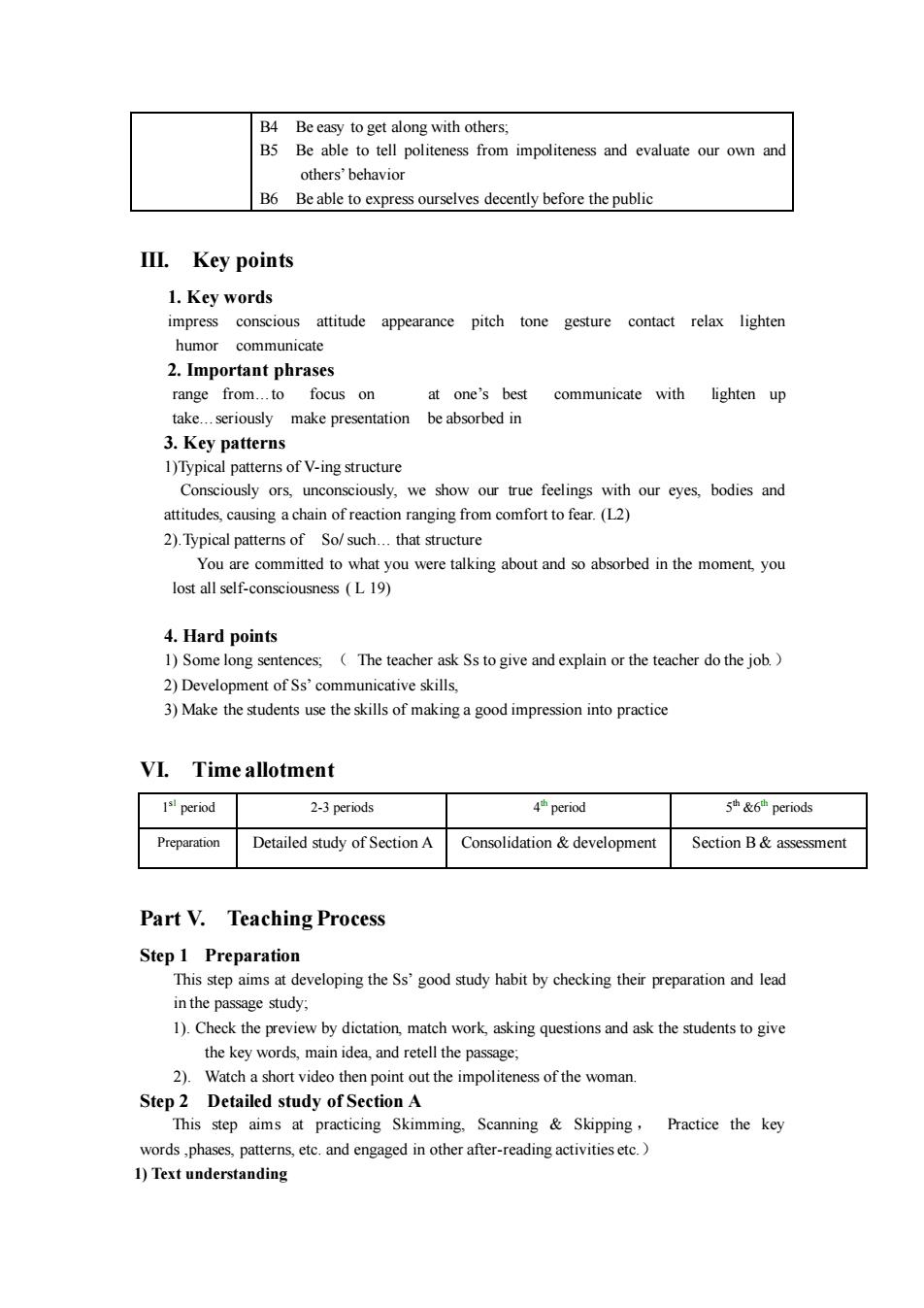
B4 Beeasy to get along with others B5 Be able to tell politeness from impoliteness and evaluate our own others'behavior B6 Be able to express ourselves decently before the public III.Key points 1.Key words impress conscious attitude appearance pitch tone gesture contact relax lighten humor communicate 2.Important phrases range from focus on at one's best communicate with lighten up take.seriously make presentation be absorbed in 3.Key patterns 1)Typical patterns of V-ing structure Consciously ors,unconsciously,we show our true feelings with our eyes,bodies and attitudes,causing achain of reaction ranging from fear.(L2) You are committed to what you were talking about and so absorbed in the moment you lost all self-consciousness (L19) 4.Hard points 1)Some long sentences. The teacher ask Ss togive and explain or the teacher do the job.) 2)Development of Ss'communicative skills, 3)Make the students use the skills of making a good impression into practice VI.Time allotment 2-3 periods 4 period periods Preparation Detailed study of Section A Consolidation&development Section B&assessment Part V.Teaching Process Step 1 Preparation This step aims at developing the Ss'good study habit by checking their preparation and lead in the r ssage study. 1).Check the preview by dictation,match work asking questions and ask the students to give the key words,main idea,and retell the passage: 2).Watch a short video then point out the impoliteness of the woman. Step 2 Detailed study of Section A This step aims at practicing Skimming.Scanning&Skipping Practice the key words.phases,.and enaed activitieset. 1)Text understanding
B4 Be easy to get along with others; B5 Be able to tell politeness from impoliteness and evaluate our own and others’ behavior B6 Be able to express ourselves decently before the public III. Key points 1. Key words impress conscious attitude appearance pitch tone gesture contact relax lighten humor communicate 2. Important phrases range from.to focus on at one’s best communicate with lighten up take.seriously make presentation be absorbed in 3. Key patterns 1)Typical patterns of V-ing structure Consciously ors, unconsciously, we show our true feelings with our eyes, bodies and attitudes, causing a chain of reaction ranging from comfort to fear. (L2) 2).Typical patterns of So/ such. that structure You are committed to what you were talking about and so absorbed in the moment, you lost all self-consciousness ( L 19) 4. Hard points 1) Some long sentences; ( The teacher ask Ss to give and explain or the teacher do the job.) 2) Development of Ss’ communicative skills, 3) Make the students use the skills of making a good impression into practice VI. Time allotment 1 s1 period 2-3 periods 4 th period 5 th &6th periods Preparation Detailed study of Section A Consolidation & development Section B & assessment Part V. Teaching Process Step 1 Preparation This step aims at developing the Ss’ good study habit by checking their preparation and lead in the passage study; 1). Check the preview by dictation, match work, asking questions and ask the students to give the key words, main idea, and retell the passage; 2). Watch a short video then point out the impoliteness of the woman. Step 2 Detailed study of Section A This step aims at practicing Skimming, Scanning & Skipping , Practice the key words ,phases, patterns, etc. and engaged in other after-reading activities etc.) 1) Text understanding
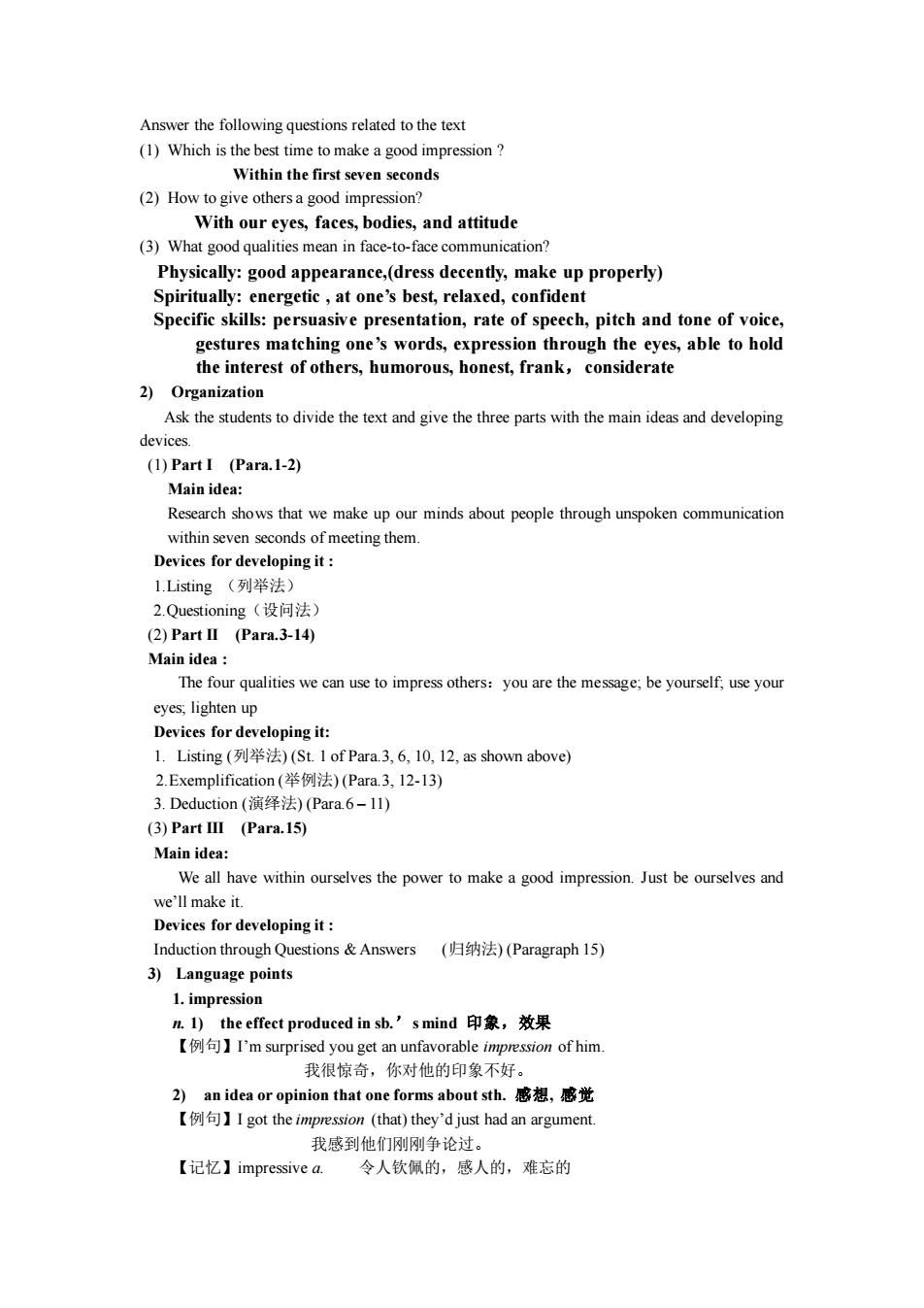
Answer the following questions related to the text (1)Which is the best time to makea good impression? Within the first seven second (2)How to give othersa good impression With our eves.faces.bodies,and attitude (3)What good qualities mean in face-to-face communication? Physically:good appearance,(dress decently,make up properly energetic at one's b relaxed,confiden Specific skills:persuasive presentation,rate of speech,pitch and tone of voice gestures matching one's words,expression through the eyes,able to hold the interest of others,humorous,honest,frank,considerate 2)Organization Ask the students to divide the text and give the three parts with the main ideas and developing devices (1)Part I (Para.1-2) Main idea: Research shows that we make up our minds about people through unspoken communication within seven seconds of meeting Devices for devel ing it: 1.Lsng(列举法 2.Questioning(设间法】 (2)PartⅡ(Para.3-14) Main idea The four qualities we can use to impress others:you are the message be eyes,lighten up Devices for developing it: L.Listing(列举法)(St1 of Para.3,6,10,12,as shown above)) 2.Exemplification(举例法)(Para3,12-13) 3.Deduction(演绎法)Para6-1) 3)PartⅢPara.l5 Main idea We all have within ourselves the power to make a good impression.Just be ourselves and we'll make it Devices for developing it: estions&Answers (归纳法)(Paragraph15) 3)Language point 1.impression nl)the effect produced in sb.’smind印象,s效果 【f例句】I'm surprised you get an unfavorable impression of him 我很惊奇,你对他的印象不好。 2) an idea or opinion that one forms about sth.感想,感觉 【例句】I got the impression(that)they'd just had an argument. 我感到他们刚刚争论过。 【记亿】impressive a. 令人钦佩的,感人的,难忘的
Answer the following questions related to the text (1) Which is the best time to make a good impression ? Within the first seven seconds (2) How to give others a good impression? With our eyes, faces, bodies, and attitude (3) What good qualities mean in face-to-face communication? Physically: good appearance,(dress decently, make up properly) Spiritually: energetic , at one’s best, relaxed, confident Specific skills: persuasive presentation, rate of speech, pitch and tone of voice, gestures matching one’s words, expression through the eyes, able to hold the interest of others, humorous, honest, frank,considerate 2) Organization Ask the students to divide the text and give the three parts with the main ideas and developing devices. (1) Part I (Para.1-2) Main idea: Research shows that we make up our minds about people through unspoken communication within seven seconds of meeting them. Devices for developing it : 1.Listing (列举法) 2.Questioning(设问法) (2) Part II (Para.3-14) Main idea : The four qualities we can use to impress others:you are the message; be yourself; use your eyes; lighten up Devices for developing it: 1. Listing (列举法) (St. 1 of Para.3, 6, 10, 12, as shown above) 2.Exemplification (举例法) (Para.3, 12-13) 3. Deduction (演绎法) (Para.6 – 11) (3) Part III (Para.15) Main idea: We all have within ourselves the power to make a good impression. Just be ourselves and we’ll make it. Devices for developing it : Induction through Questions & Answers (归纳法) (Paragraph 15) 3) Language points 1. impression n. 1) the effect produced in sb.’s mind 印象,效果 【例句】I’m surprised you get an unfavorable impression of him. 我很惊奇,你对他的印象不好。 2) an idea or opinion that one forms about sth. 感想, 感觉 【例句】I got the impression (that) they’d just had an argument. 我感到他们刚刚争论过。 【记忆】impressive a. 令人钦佩的,感人的,难忘的
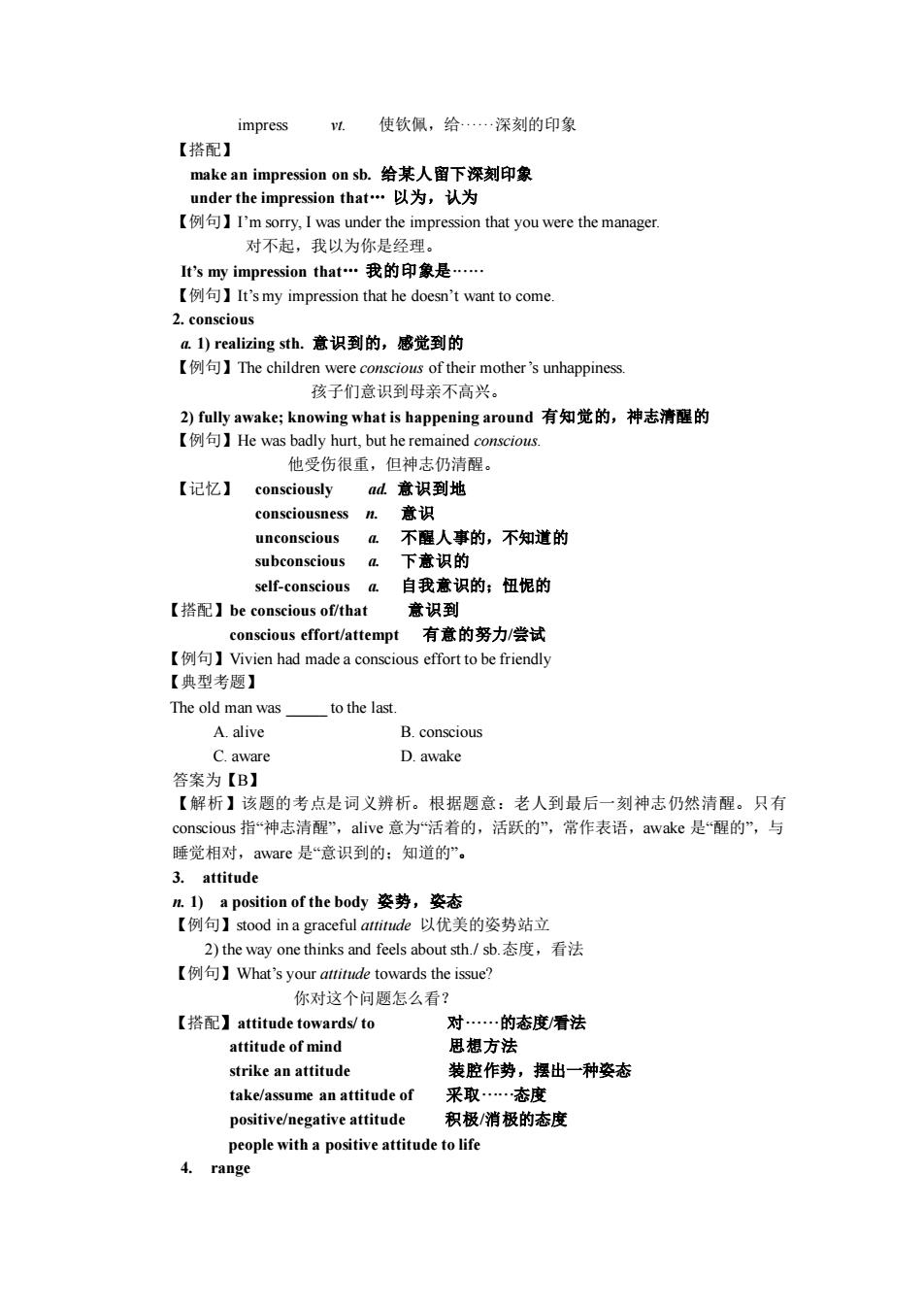
impress 以使软佩,给.深刻的印象 【搭配】 make an impression on sb.给某人留下深刻印象 under the impression that.以为,认为 【例句】I'm sorry,I was under the impression that you were the manager 对不起,我1为你是经理 's my impression that.我的印象是 【f例句】t'smy impression that he doesn'want to come 2.conscious al)realizing sth.意识到的,感觉到的 【例句】The children were conscious of their mother's unhappiness 孩子们意识到母亲不高兴。 awake;kn ving what is happening around有知觉的,神志清醒的 他受伤很重,但神志仍清醒。 【记忆】consciously ad意识到地 onsciousness.意识 不醒人事的,不知道的 onscious 下意识的 self-conscious a. 自我意识的:忸怩的 【搭配】be conscious of/hat 意识到 conscious effort/attempt 有意的努力/尝试 【例句】Vivien had made a c effort to be friendly 【典型考题】 The old man was to the last A.alive B.conscious C aware D.awake 答案为【B】 【解析】该题的考点是词义辨析。根据题意:老人到最后一刻神志仍然清醒。只有 conscious指“神志 者醒 aive意为活着的,活跃的”,常作表语,wkc是“醒的”,与 睡觉相对,aware是“意识到的:知道的”。 3.attitude n.1)a position of the body姿势,姿态 【例句】stood e6ulde以伏美的热站立 2)the wayone thinks and feels about sth/sb.态度,看法 【例句】What's your attitde towards the issue? 你对这个问题怎么看 【搭配】attitude towards/to 对.的态度看法 attitude of mind 思想方法 strike an attitude 装腔作势,摆出一种姿态 take/assume an attitude of 采取 "态度 positive/negative attitude 积极/消极的态度 people with a positive attitude to life 4.range
impress vt. 使钦佩,给······深刻的印象 【搭配】 make an impression on sb. 给某人留下深刻印象 under the impression that. 以为,认为 【例句】I’m sorry, I was under the impression that you were the manager. 对不起,我以为你是经理。 It’s my impression that. 我的印象是······ 【例句】It’s my impression that he doesn’t want to come. 2. conscious a. 1) realizing sth. 意识到的,感觉到的 【例句】The children were conscious of their mother’s unhappiness. 孩子们意识到母亲不高兴。 2) fully awake; knowing what is happening around 有知觉的,神志清醒的 【例句】He was badly hurt, but he remained conscious. 他受伤很重,但神志仍清醒。 【记忆】 consciously ad. 意识到地 consciousness n. 意识 unconscious a. 不醒人事的,不知道的 subconscious a. 下意识的 self-conscious a. 自我意识的;忸怩的 【搭配】be conscious of/that 意识到 conscious effort/attempt 有意的努力/尝试 【例句】Vivien had made a conscious effort to be friendly 【典型考题】 The old man was _ to the last. A. alive B. conscious C. aware D. awake 答案为【B】 【解析】该题的考点是词义辨析。根据题意:老人到最后一刻神志仍然清醒。只有 conscious 指“神志清醒”,alive 意为“活着的,活跃的”,常作表语,awake 是“醒的”,与 睡觉相对,aware 是“意识到的;知道的”。 3. attitude n. 1) a position of the body 姿势,姿态 【例句】stood in a graceful attitude 以优美的姿势站立 2) the way one thinks and feels about sth./ sb.态度,看法 【例句】What’s your attitude towards the issue? 你对这个问题怎么看? 【搭配】attitude towards/ to 对······的态度/看法 attitude of mind 思想方法 strike an attitude 装腔作势,摆出一种姿态 take/assume an attitude of 采取······态度 positive/negative attitude 积极/消极的态度 people with a positive attitude to life 4. range
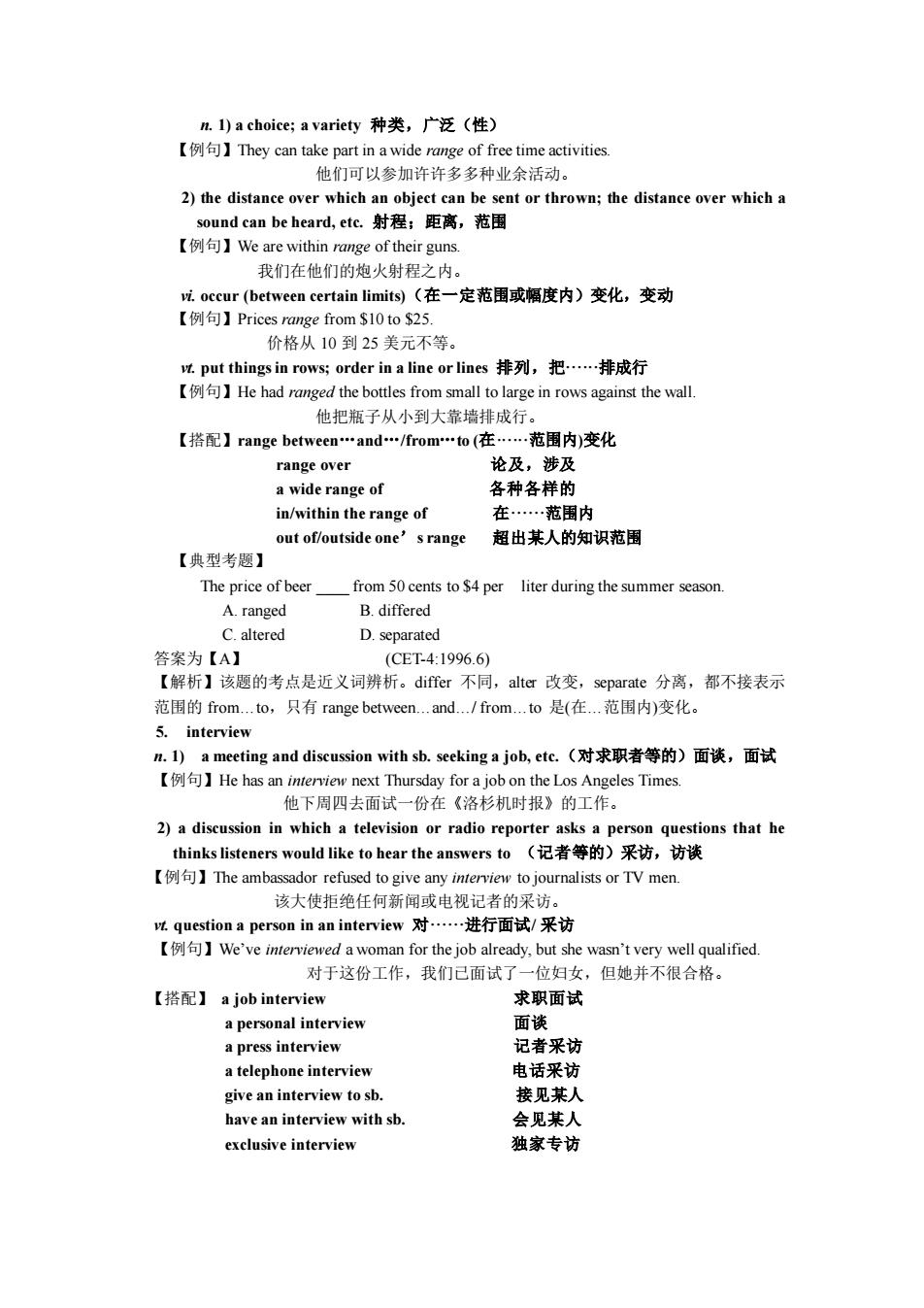
n)a choice;:a variety种类,广泛(性) free time activities 2)the distance over which an object can be sent or thrown;the distance over whicha sound can be heard,.etc.射程:距离,范围 【例句】Ne are within range of their guns. 我们在他们的炮火射程之内」 r(between certain limits)( 定范围或幅度内)变化,变动 【例句】Prices efrom $10 to $25 价格从10到25美元不等。 t.put things in rows;order in a line or lines排列,把排成行 【例句】He had ranged the bottles from small to large in rows against the wal. 他把瓶子从小到大靠培排成行 【搭配】range betweenand.fom.o(在 范内)变化 range over 及,涉及 a wide range of 各种各样的 in/within the range of 在.范围内 out offoutside one'srange 超出某人的知识范围 【典型考趣】 The price of beerfrom 50 cents to $4 per liter during the summer season A.ranged B.differed C.altered D separated 答案为【A】 (CET4:1996.6) 【解析】该愿的考点是近义词辨析。differ不同,a改变,separate分离,都不接表示 范围的fiom.to,只有range between.and /om.to是(在范围内)变化。 5.interview n.1)a meeting and discussion with sb.seeking a job,.etc.(对求职者等的)面谈,面试 【例句】He has an interview next Thursday for a iob on the los angeles Times 他下周四去面试一份在《洛杉机时报》的工作。 2)a discussion in which a televisio or radio reporter s a pers que ons that he thinks listeners would like to hear the answers to(记者等的)采访,访谈 【例句】The ambassador refused to give any interview to journalists or TV men. 该大使拒绝任何新闻或电视记者的采访。 t.question a person in an interview对.进行面试/采访 【例句】We've man for the job already,but well qualified 对于这份工作,我们已面试 位妇女 但她并不很合格, 【搭配】a job interview 求职面试 a personal interview 面谈 a press interview 记者采访 atelephone intervie 电话采访 give an interview to s 接见某人 have an interview with sb. 会见某人 exclusive interview 独家专访
n. 1) a choice; a variety 种类,广泛(性) 【例句】They can take part in a wide range of free time activities. 他们可以参加许许多多种业余活动。 2) the distance over which an object can be sent or thrown; the distance over which a sound can be heard, etc. 射程;距离,范围 【例句】We are within range of their guns. 我们在他们的炮火射程之内。 vi. occur (between certain limits)(在一定范围或幅度内)变化,变动 【例句】Prices range from $10 to $25. 价格从 10 到 25 美元不等。 vt. put things in rows; order in a line or lines 排列,把······排成行 【例句】He had ranged the bottles from small to large in rows against the wall. 他把瓶子从小到大靠墙排成行。 【搭配】range between.and./from.to (在······范围内)变化 range over 论及,涉及 a wide range of 各种各样的 in/within the range of 在······范围内 out of/outside one’s range 超出某人的知识范围 【典型考题】 The price of beer _ from 50 cents to $4 per liter during the summer season. A. ranged B. differed C. altered D. separated 答案为【A】 (CET-4:1996.6) 【解析】该题的考点是近义词辨析。differ 不同,alter 改变,separate 分离,都不接表示 范围的 from.to,只有 range between.and./ from.to 是(在.范围内)变化。 5. interview n. 1) a meeting and discussion with sb. seeking a job, etc.(对求职者等的)面谈,面试 【例句】He has an interview next Thursday for a job on the Los Angeles Times. 他下周四去面试一份在《洛杉机时报》的工作。 2) a discussion in which a television or radio reporter asks a person questions that he thinks listeners would like to hear the answers to (记者等的)采访,访谈 【例句】The ambassador refused to give any interview to journalists or TV men. 该大使拒绝任何新闻或电视记者的采访。 vt. question a person in an interview 对······进行面试/ 采访 【例句】We’ve interviewed a woman for the job already, but she wasn’t very well qualified. 对于这份工作,我们已面试了一位妇女,但她并不很合格。 【搭配】 a job interview 求职面试 a personal interview 面谈 a press interview 记者采访 a telephone interview 电话采访 give an interview to sb. 接见某人 have an interview with sb. 会见某人 exclusive interview 独家专访